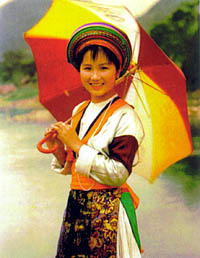Home » History of Vietnam » People from the Northern Highlands
Vietnam’s Ethnic Minorities
Minorities of the Northern Highlands

The mountains of northern Vietnam are home to a large number of ethnic groups, all of them originating from southern China. The dominant minorities are the Tay and Thai, both feudal societies who once held sway over their weaker neighbours. These powerful well-established groups farm the fertile, valley-bottom land; while the Hmong and Dzao people, who only arrived in Vietnam at the end of the eighteenth century, occupy the least hospitable land at the highest altitudes. These isolated groups have been better able to lead an independent life and to preserve their traditional customs, though most exist at near-subsistence levels. Local markets, usually held at weekly intervals, fulfill an important role in social and economic life in the highlands; the best known is at Sa Pa, though there are others throughout the area. Most groups maintain a tradition of alternate singing, which is performed at ceremonies and festivals.
Tay
The Tay are Vietnam’s largest minority group living in the highlands, with an estimated population of 1.2 million, concentrated in the northeast, from the Red River Valley east to the coastal plain, where they settled over 2000 years ago. Through centuries of close contact with lowlanders, Tay society has been strongly influenced by Viet culture, sharing many common rituals and Confucian practices. Many Tay have now adopted Viet architecture and dress, but its still possible to find villages of thatched stilthouses, characterized by a railed balcony around the building. Nowadays it’s largely the women who still wear the Tay’s traditional long, belted dress of indigo-dyed cloth, with a similarly plain, knotted headscarf peaked at the front and set off with lots of silver jewellery. Tay farmers are famous for their animal husbandry, and they also specialize in fish-farming and growing high value crops. such as anise, tobacco, soya and cinnamon. The Tay are known for their abilities in cultivating wet rice in addition to crops such as tobacco, fruit, herbs and spices. Religiously they adhere closely to Vietnamese beliefs in Buddhism, Confucianism and Taoism, but also worship genies and local spirits. In the 16th century, the Tay developed their own written script and Tay literature and arts have gained substantial renown.The Tay have developed advanced irrigation systems for wet-rice cultivation, including the huge water wheels found beside rivers in the northeast. They have had a written language since the sixteenth century, fostering a strong literary tradition; alternate singing is also popular, as are theatrical performances, kite-fly ing and a whole variety of other games. Some Tay groups in the more remote regions occasionally erect a funeral house, decorated with fluttering slips of white paper, over a new grave.
Muong
The lower hills from the Red River Valley south through Yen Bai, and Son La down to Thanh Hoa are the domain of the Muong ethnic minority, with the majority now living in Hoa Binh Province. Muong people, totalling just under 1 million, are believed to share common ancestors with the Viet. It’s thought that the two groups split around 2000 years ago, after which the Muong developed relatively independently in the highlands. Society is traditionally dominated by aristocratic families, who distribute communal land to the villagers in return for labour and tax contributions; the symbols of their authority are drums and bronze gongs. Muong stilthouses are similar to those built by the Thai, and the main staple is rice, though fishing, hunting and gathering are all still fairly important. Muong people have a varied cultural tradition. including alternate singing and epic tales, and they are famed for their embroidery, typically creating bold geometric designs in black and white. Older Muong women continue to wear the traditional long black skirt and close-fitting shirt; a broad, heavily embroidered belt is the main accessory, and many women also wear a simple white headscarf. The male-dominated Muong live in small stilt-house hamlets called quel, which are grouped into larger village units called muong. Each muong is overseen by an hereditary noble family (lang) who rules the communal land and collects the benefits of labour and tax through the use of it by locals. Though their origins lie close to the ethnic-Vietnamese and they are nowadays difficult to distinguish, the Muong have a rich culture and are more similar to the Tai. They are known for producing notable folk literature, poems and songs, much of which has been translated into Vietnamese. They too cultivate rice in water paddies, though in the past sticky rice, like that found in Laos and north-east Thailand, was part of their staple diet.
Nung
Nung people are closely related to the Tay, sharing the same language and often living in the same villages. Their population is estimated at 700,000, mostly in Cao Bang and Lang Son provinces, where they have a long tradition of cultivating wet rice, using water wheels for irrigation. Concentrated into small villages, Nung homes are typically divided into two sections, one to serve as living quarters and the other for work and worship. Their astute gardening skills are known to reap a wide variety of healthy crops like vegetables, maize, groundnuts, fruit, spices and bamboo. Nung farmers terrace the lower slopes to provide extra land. In fact, the Nung are reckoned to be the best horticulturalists in Vietnam, while their black smiths are almost as renowned. Unusually, the traditional Nung house has clay walls and a tiled roof, and is built either flat on the ground or with only one section raised on stilts. Most Nung are Buddhist, worshipping Quan Am, though they also honour the spirits and their ancestors. They are particularly adept at alternate singing, relishing the improvised double entendre. Not surprisingly, Nung traditional dress is similar to the Tay, though hemmed with coloured bands. Women often sport a neck scarf with brightly coloured fringes and a shoulder bag, embroidered with the sun, stars and flowers, or woven in black and white interspersed with delicately coloured threads.In addition to weaving, the Nung are known for their handicrafts such as bamboo furniture, basketry, silverwork and paper making. Spiritually and socially, the Nung are similar to the Tay, from their deep ancestral worship to traditional festivities. Both were also heavily exploited by foreign militaries (French and American). Nung brides traditionally command high dowries from prospective grooms and tradition dictates inheritance from father to son, a sign of strong Chinese influences. In most Nung villages medicine men still exist and are called upon to help get rid of evil spirits and cure the ill.
© C Jan Dodd – The Rough Guide to Vietnam

